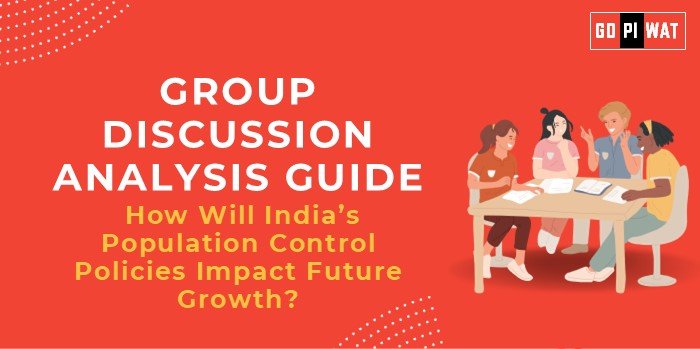📋 Group Discussion (GD) Analysis Guide
🌐 How Will India’s Population Control Policies Impact Future Growth?
🌟 Introduction
• Opening Context: As of April 2023, India became the world’s most populous country with a population of 1.425 billion. Population control policies are pivotal for shaping its future economic and social trajectory.
• Topic Background: India’s journey from a high fertility rate of 6.18 children per woman in 1950 to achieving a Total Fertility Rate (TFR) of 2.0 in 2021 reflects significant strides in population control. Yet, challenges like urban overcrowding and resource strain persist, necessitating well-rounded policies.
📊 Quick Facts and Key Statistics
- Population Size: 1.425 billion – India became the most populous country in April 2023.
- Fertility Rate: 2.0 in 2021 – Below the replacement level of 2.1, marking a historical achievement.
- Youth Demographic: 27.2% of the population is aged 15-29 (2021), a potential engine for economic growth.
- Urban Population: 36.6% as of 2024 – Urbanization challenges include housing and infrastructure strain.
🧑🤝🧑 Stakeholders and Their Roles
- Government Bodies: Develop and implement population policies at the national and state levels.
- Healthcare Sector: Provide reproductive healthcare and family planning resources.
- Non-Governmental Organizations (NGOs): Drive grassroots awareness and community-level advocacy.
- International Agencies: Offer technical and financial support (e.g., UNFPA, WHO).
- Citizens: Act as the key agents for adopting family planning practices and ensuring compliance with policies.
📈 Achievements and Challenges
- Achievements:
- Fertility Rate Decline: Reduced from 6.18 in 1950 to 2.0 in 2021.
- Awareness Campaigns: Initiatives like Mission Parivar Vikas have improved access to contraception and healthcare.
- Economic Potential: A large youth demographic offers a unique opportunity to harness the demographic dividend.
- Challenges:
- Urban Overcrowding: With 36.6% of the population in cities, infrastructure and housing demands remain unmet.
- Cultural Barriers: Resistance to family planning in certain regions and communities.
- Aging Concerns: A potential future challenge as fertility rates continue to decline.
🌏 Global Comparisons
- China: One-child policy alleviated population growth but created an aging crisis.
- Japan: Struggles with workforce shortages due to prolonged low fertility rates.
💡 Effective Discussion Approaches
- Opening Approaches:
- “India’s population milestone offers both opportunities and challenges for its growth trajectory.”
- “Balancing population control with economic needs will be crucial as India navigates its future.”
- Counter-Argument Handling:
- Address concerns by comparing India’s policies with global success stories like Singapore’s balanced approach.
- Highlight data-backed solutions to challenges like urbanization and aging.
📋 Strategic Analysis of Strengths & Weaknesses
- Strengths:
- A youthful population offering labor market advantages.
- Steady decline in fertility rates reflecting policy success.
- Weaknesses:
- Regional disparities in policy implementation.
- Urban infrastructure struggling to meet demand.
- Opportunities:
- Leveraging education and skilling to maximize the demographic dividend.
- Developing equitable urban and rural policies to manage population distribution.
- Threats:
- Rising aging population in the long term.
- Overburdened urban infrastructure leading to reduced quality of life.
📌 Structured Arguments for Discussion
- Supporting Stance: “Effective population control ensures sustainable resource allocation and enhances quality of life.”
- Opposing Stance: “Restrictive population policies risk an aging workforce and stunted economic growth.”
- Balanced Perspective: “While population control is necessary, its implementation must consider economic sustainability and regional disparities.”
📚 Connecting with B-School Applications
- Real-World Applications: Policy analysis in resource management, urban planning, and healthcare projects.
- Sample Interview Questions:
- “What are the long-term economic impacts of declining fertility rates in India?”
- “How can India balance urbanization challenges with population control measures?”
- Insights for Students: Understand policy implications on labor markets and resource management to inform business and social strategies.


